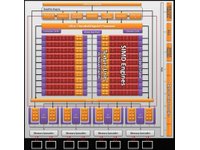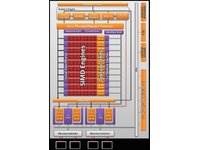AVADirect's W860CU: Mobility Radeon HD 5870 Vs. GeForce GTX 285M
Custom system builder AVADirect is one of the few companies to offer the flexibility of multiple graphics modules within the same notebook model. We used its high-end W860CU to compare AMD's and Nvidia's highest-performance mobile graphics processors.
Graphic Details
Though the Clevo W860CU is a nice desktop replacement notebook and AVADirect expertly configured our samples, the actual technology behind the graphics cards is completely out of the hands of those companies. Specifically, the graphics processors are not at all what buyers might expect them to be.
| Desktop vs. Mobility Radeon Graphics | |||
|---|---|---|---|
| Row 0 - Cell 0 | Desktop Radeon HD 5870 | Desktop Radeon HD 5770 | Mobility Radeon HD 5870 |
| Transistors | 2.15 billion | 1.04 billion | 1.04 billion |
| Engine Clock | 850 MHz | 850 MHz | 700 MHz |
| Shader (ALUs) | 1,600 | 800 | 800 |
| Texture Units | 80 | 40 | 40 |
| Z/Stencil Units | 128 | 64 | 64 |
| Compute Performance | 2.72 TFLOPS | 1.36 TFLOPS | 1.12 TFLOPS |
| DRAM Type | GDDR5-4800 | GDDR5-4800 | GDDR5-4000 |
| DRAM Interface | 256-bits | 128-bits | 128-bits |
| Memory Bandwidth | 153.6 GB/s | 76.8 GB/s | 64.0 GB/s |
| TDP | 188W | 108W | 50W |
In response to last summer’s exposé
, Nvidia told us that its highest-model notebook GPU gets a similar name as its highest-model desktop GPU simply so people would understand that both cards represent the highest model of each market. Representatives of the firm vigorously denied that the naming similarity inferred a similar performance level, though we contend that this is the type of assumption Nvidia hopes buyers will make. In the case linked above, it’s easy to see that the GeForce GTX 285M bears no relation to the GeForce GTX 285, that these use completely different architectures, and that the GeForce GTX 285M architecture is taken directly from the old GeForce 8800 GTS 512MB GPU. Beyond basic underclocking, several updates used in the transformation from GeForce 8800 GTS 512MB to a GeForce GTX 285M make the newer version cheaper to produce and more energy efficient.
Nvidia stood alone in last summer in using an inferior core for its “premium” mobile offering, but it appears that AMD is learning its rival’s tricks. That is to say, while last summer’s Mobility Radeon products were simply underclocked variations of similarly-named desktop models, the company’s latest “premium” mobile model is nothing more than half of its desktop namesake.


Recognizing these images from our previous Radeon HD 5770 launch article, some readers will undoubtedly think we got our pictures mixed up. The “high end” Mobility Radeon HD 5870 can’t be based on the mid-market desktop Radeon HD 5770, can it?
| Desktop vs. Mobile GeForce Graphics | |||
|---|---|---|---|
| Row 0 - Cell 0 | Desktop GeForce GTX 285 | Desktop GeForce 8800 GTS 512MB | GeForce GTX 285M |
| Transistors | 2.15 billion | 754 million | 754 million |
| Engine Clock | 648 MHz | 650 MHz | 576 MHz |
| Stream Processors | 240 | 128 | 128 |
| Texture Units | 80 | 64 | 64 |
| ROP Units | 32 | 24 | 24 |
| Compute Performance | 1.06 TFLOPS | 624 GFLOPS | 576 GFLOPS |
| DRAM Type | GDDR3-2484 | GDDR3-1940 | GDDR3-2040 |
| DRAM Interface | 512-bits | 256-bits | 256-bits |
| Memory Bandwidth | 159 GB/s | 64 GB/s | 65.3 GB/s |
| TDP | 183W | 135W | 75W |
Our Radeon HD 5870, Radeon HD 5770, and Mobility Radeon HD 5870 statistics come directly from the AMD Web site. The Mobility Radeon HD 5870 is not just any Radeon HD 5770, however. Instead, it’s actually an underclocked Radeon HD 5770 and is likely programmed to further enhance its power-savings capabilities.
In other words, the Mobility Radeon HD 5870 is the Radeon HD 5770’s slower, less-energetic younger brother. Yet, shoppers who can track down the mobile module will find it costs three times as much as the desktop part, even though it does not include a cooling fan, heat sink, or display outputs.
The biggest question for us is, which graphics company deserves your ire the most? While we let the readers decide the fates of AMD and Nvidia, our only hope is that their clearly-deceptive naming practices don't adversely affect honest, hard-working builders like AVADirect.
Get Tom's Hardware's best news and in-depth reviews, straight to your inbox.
-
ta152h I'm a little confused why you'd choose an i7 920 to compare with a different platform, but maybe it's because I don't know the mobile platform that well.Reply
But, if it's like the P55, which it seems to be, there's the added uncertainty of the architecture thrown in.
Particularly with PCI-E being implemented differently, you might be seeing the inferior implementation of the P55 architecture responsible for a small amount of the relatively poor mobile performance. Since this implementation needs to multiplex the memory bus of the processor, you can run into situations where there is contention.
I doubt it's significant, but I'm curious why you wouldn't want to make a comparison with a more similar desktop platform. Was it because you couldn't get an unlocked Lynnfield to get the clock speeds for the processors the same in Turbo mode?
-
This doesn't make much sense to me... if a 5870M chip = roughly a 5770 desktop chip and a 285M = roughly an 8800gts.. why is it not completely spanking it? we all know 5770>8800.. by a rather large margin! what could be the cause of this?Reply
-
anamaniac Tom's, you should show your power usage results to AMD and ask for an explanation, on why a lower rated part is using more power.Reply
Granted, with a 45W CPU and 50W GPU, 30 mins is expected on a 40W battery if fully stressed. -
jkeopka I liked this article because I found it so darn relevant... I actually have this same Clevo Laptop, with the 5870 and 8 gigs of RAM.Reply
The GTX 285M was a $50 premium over the 5870, and I am glad I chose to stick to the 5870. It is kind of strange one would pay more to have less performance. I guess thats what fanboyism are all about? -
jkeopka anamaniacHow many partners use Clevo laptops and just rebrand them?Lots. Mine is a Sager 8690... which is a rebranded Clevo W860CU...Reply
I have seen this model at other sites as well. -
falchard Looks more like a bottleneck then anything conclusive. The results in nearly all the tests were close, yet 1 of them should have been clearly ahead.Reply
I think an ASUS JH73-A1 verse this would have been more interesting as its a bit cheaper for better parts. -
Crashman TA152HI'm a little confused why you'd choose an i7 920 to compare with a different platformSame speeds in Turbo mode, which is used during games, the primary focus being gaming performance.TA152HBut, if it's like the P55, which it seems to be, there's the added uncertainty of the architecture thrown in.That's true, but neither graphics solution provided the performance needed to highlight the mobile processor's on-die PCIe controller's performance advantage.TA152HI'm curious why you wouldn't want to make a comparison with a more similar desktop platform. Was it because you couldn't get an unlocked Lynnfield to get the clock speeds for the processors the same in Turbo mode? Exactly. Besides, Tom's Hardware has already seen that clock-for-clock, Lynfield games at least as well as Bloomfield when a single card is used. If nothing else, the comparison favors the mobile solution's lower power consumption.Reply
